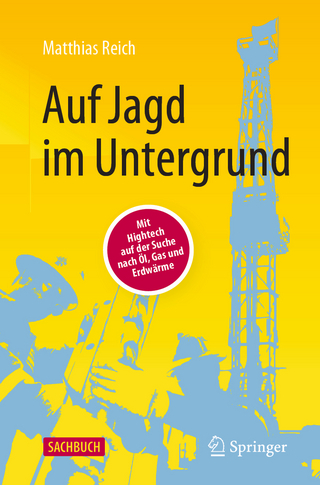
The Origins of Natural Diamonds
Wiley-Scrivener (Verlag)
978-1-119-59344-7 (ISBN)
Valuable as either a learning tool for the student or as a reference or refresher for the veteran scientist or engineer, the author explains important geological processes, such as the Earth’s origin, composition, and structure, the Earth’s energy balance, continental drift, tectonic activity, the evolution of the Earth’s crust, and others. It is within this geological framework that the author offers practical guidance for engineers and scientists who work in industry or academia. It is a must-have for any geologist, geophysicist, or engineer working in mining or petroleum engineering.
N. O. Sorokhtin is a geologist and academician of the Russian Academy of Natural Sciences and has participated in over 20 major geological expeditions and author of more than 100 scientific publications, including six monographs. He is a co-author of The Evolution of Earth's Climate, also available from Wiley-Scrivener.
Foreword xi
Introduction xii
1 Major Parameters of Diamond-Bearing and Affine Rocks 1
2 Issues of the Diamond-Bearing Rocks’ Origin 7
3 Existing Concepts of the Diamond-Bearing Rocks Origin 11
4 Earth’s Origin, Composition and Structure 19
4.1 Energy and Heat Regimes of Young Earth 33
4.2 The Gadeyan Stage of Earth’s Evolution 35
5 The Earth’s Core Formation Process 41
5.1 Delayed Earth’s Core Separation Process 41
5.2 Earth’s Core Separation 45
5.3 Mechanism of Earth’s Matter Zonal Differentiation 50
5.4 Earth’s Matter Barodiffusion Differentiation 63
5.5 Earth’s Core Growth 75
5.6 Evolution of the Mantle Chemical Composition 82
5.7 Geologic Data About Earth’s Core Separation Time 93
6 Earth’s Energy Balance 103
6.1 The Accretion and Differentiation Earth’s Energy 104
6.2 Radioactive Elements and their Decay Energy 110
6.3 Earth’s Deceleration Tidal Energy 123
6.4 Earth’s Heat Losses 129
6.5 Earth’s Energy Balance and Tectonic Activity 134
6.6 Сalculation Parameters of Earth’s Tectonic Activity 138
6.7 Convecting Mantle Temperature Evolution 141
7 The Nature of Earth’s Tectonic Activity 145
7.1 Possible Causes of Earth’s Tectonic Activity 145
7.2 Possible Mechanisms of Lithospheric Plates Drift 149
7.3 The Nature of the Mantle Convection 156
7.4 Evolution of Earth’s Tectonic Activity Parameters 171
8 Earth’s Crust Evolution 175
8.1 Patterns in the Formation of Oceanic Lithospheric Plates 175
8.2 Formation of the Continental Crust in Archaean 181
8.3 The Continental Crust Growth 185
8.4 Major Features in the Composition of the Continental Crust in Archaean 190
8.5 Tectonic Regimes of the Continental Lithosphere Formation in Early Precambrian 196
8.6 Early Pre-Cambrian Continental Lithosphere Formation Mechanisms 201
8.7 Formation Mechanism of Lithospheric Plates and the Origin of Mid-Oceanic Ridges 219
8.8 Structure of Lithospheric Plate Subduction Zones 231
8.9 Geodynamics of the Plate Subduction Zones 237
8.10 The Mechanism of Pulling Oceanic Deposits in Subduction Zones 240
9 Continental Drift in Earth’s Geological History 249
9.1 Continental Shields’ Evolution in Archaean 249
9.2 Formation of Monogea Supercontinent at the End Archaean 252
9.3 Monogea Disintegration and the Formation of Megagea Supercontinent in Early Proterozoic 254
9.4 Disintegration of Megagea and Formation of Mesogea (Rodinia) Supercontinent in Middle Riphaean 258
9.5 Mesogea Disintegration in Late Riphaean and Formation of Pangea Supercontinent at the End Paleozoic – Early Mesozoic 263
10 Mantle Degassing and the Formation of Earth’s Hydrosphere and Atmosphere 271
10.1 The Primary Mantle Degassing 271
10.2 Seas and Oceans Formation on Earth Surface 275
10.3 Hydrothermal Processes on the Ocean Floor 282
10.4 The Nature of Global Marine Transgressions on Continents 289
10.5 Earth’s Tectonic Activity vs. Fluctuations of the World Ocean Level 291
10.6 Earth’s Primordial Atmosphere 294
10.7 Evolution of the Degassing Process of Carbon Dioxide Gas 295
10.8 Evolution of Nitrogen Partial Pressure 303
10.9 Evolution of Oxygen’s Partial Pressure 307
10.10 Abiogenous Methane Generation Patterns 312
10.11 The Evolution of Earth Atmosphere Composition and Pressure 321
11 Some Patterns of Economic Minerals’ Formation in Earth’s History 325
11.1 Mechanisms of Riftogenic Earth’s Crust Benefication with Ore and Lithophilic Elements 326
11.2 The Subduction Zone Metallogeny 330
11.3 Metallogeny of Early Stage in Earth Evolution and the Nature of a Unique Early Proterozoic Ore Formation Epoch 356
11.4 The Influence of the Ocean and of Earth Climates on the Formation of Sedimentary Commercial Minerals in Early Proterozoic, the Major Iron Ore Accumulation Epoch 361
12 Diamond Origin and the Formation of Kimberlite and their Affine Rocks 369
13 Carbon’s Depth Cycle 397
14 Isotopic Geochemistry of Diamonds and Kimberlites 411
15 Kimberlite Magma Rise Mechanism to Earth’s Surface 433
16 The Forecast Criteria of Diamond Magmatism Localization Zones and the Evolution of Some Diamond-Bearing Provinces 443
16.1 Some Formation Examples of World Diamond-Bearing Provinces 445
16.2 Geodynamical Evolution of the Western Part of the Russian Arctic and its Diamond-Bearing 450
16.3 The Zoning of Alkali-Ultramafic and Kimberlite Magmatism Localization Areas in the Northeastern Part of the Baltic Shield 470
Conclusions 477
References 483
Index 509
| Erscheinungsdatum | 15.08.2019 |
|---|---|
| Sprache | englisch |
| Maße | 10 x 10 mm |
| Gewicht | 454 g |
| Themenwelt | Naturwissenschaften ► Chemie |
| Naturwissenschaften ► Geowissenschaften ► Geologie | |
| ISBN-10 | 1-119-59344-1 / 1119593441 |
| ISBN-13 | 978-1-119-59344-7 / 9781119593447 |
| Zustand | Neuware |
| Haben Sie eine Frage zum Produkt? |
aus dem Bereich


